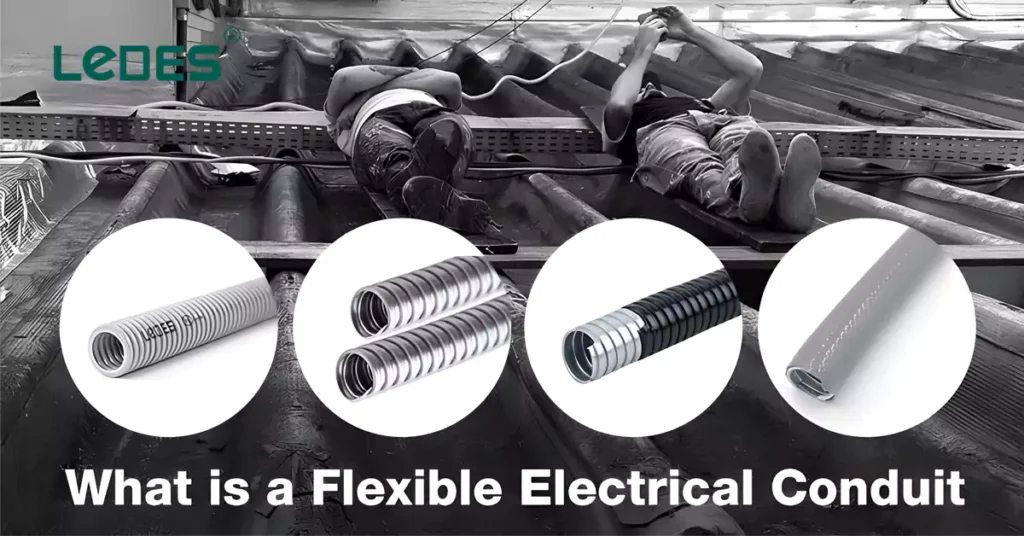
Inhaltsverzeichnis
Flexible Leitungen, auch als flexible Schläuche oder flexibles Leitungsrohr bekannt, sind Schutzrohre zum Verlegen und Schützen von elektrischen Leitungen, Kabeln und anderen Leitern. Sie bestehen typischerweise aus einem haltbaren und biegsamen Material wie Kunststoff oder Metall, das sich biegen und verformen lässt, ohne dass die Drähte im Inneren brechen oder beschädigt werden. Flexible Leitungen bieten Flexibilität und einfache Installation in Anwendungen, in denen starre Leitungen unpraktisch oder schwierig zu verwenden sind.
Wie starre Leitungen gibt es auch flexible Leitungen in zwei Arten: aus Metall und nicht aus Metall. Beide lassen sich in unterschiedliche Typen unterteilen. Fangen wir also an.
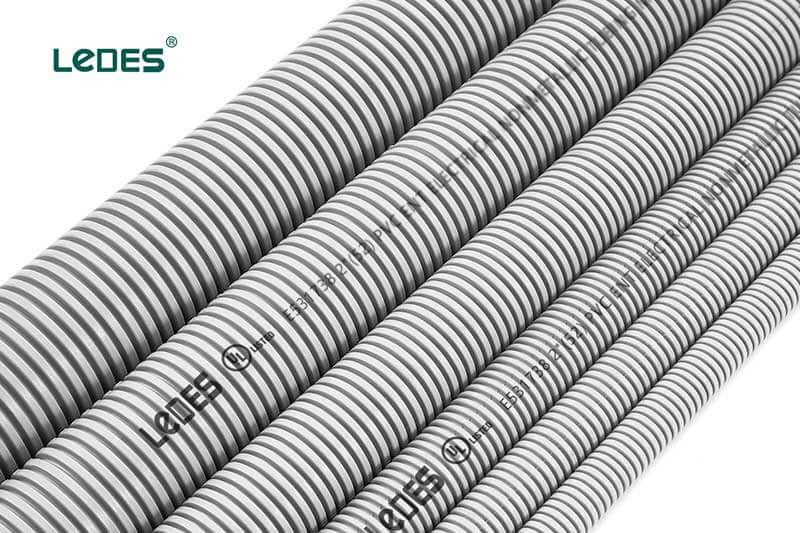
Elektrische nichtmetallische Rohre (ENT) sind die am häufigsten verwendeten flexiblen Kunststoffrohre. Es handelt sich um eine Art biegsame Kabelkanal für die Installation elektrischer Leiter. Es handelt sich um dünnwandige, gewellte Rohre mit kreisförmigem Querschnitt, die feuchtigkeitsbeständig und flammhemmend sind.
ENT besteht aus einem nichtmetallischen Material, das Feuchtigkeit und chemischen Einflüssen widersteht und so den Schutz der elektrischen Verkabelung gewährleistet. Der Kabelkanal ist biegsam, d. h. er lässt sich mit angemessenem Kraftaufwand leicht von Hand biegen, ohne dass zusätzliche Hilfe oder Werkzeuge erforderlich sind. Es ist jedoch wichtig zu beachten, dass die zugehörigen Armaturen und Steckverbinder möglicherweise nicht die gleiche Biegsamkeit aufweisen, obwohl der Schlauch selbst flexibel ist.
Im Gegensatz zu Gewinderohren weist ENT eine gewellte Form auf, die ein Gewindeschneiden überflüssig macht. Obwohl die Rohre selbst kein Gewinde aufweisen, gibt es speziell für ENT-Installationen entwickelte Fittings, die sichere Verbindungen ermöglichen. Diese Fittings und Anschlüsse sind in den ENT-Kabelkanal integriert oder mit diesem verbunden und gewährleisten eine zuverlässige und sichere Elektroinstallation.
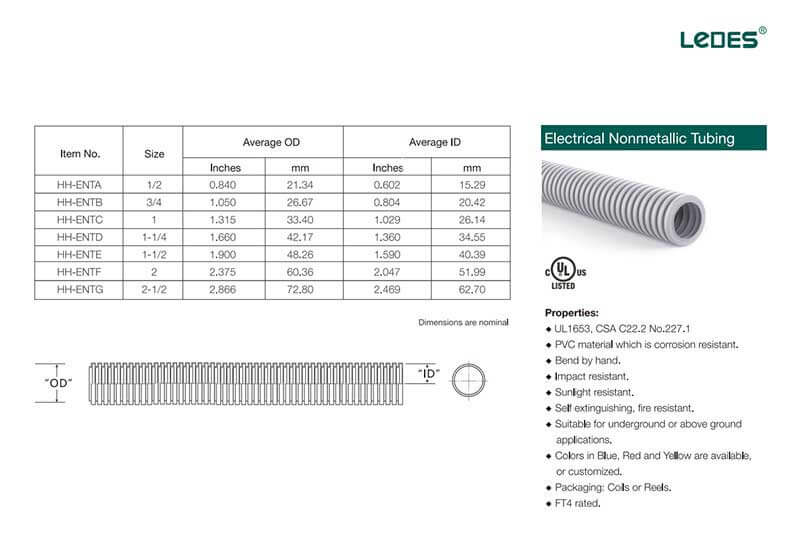
Gemäß den UL- und CSA-Standards Elektrische nichtmetallische Rohre (ENT)-Leitungen sind in den Größen 1/2 Zoll bis 1/2-2 Zoll erhältlich, wobei die Größe 1/2-2 Zoll nur in Kanada erhältlich ist.
Zusätzlich zu den Standardspezifikationen für Innendurchmesser (ID) und Außendurchmesser (OD) stellen UL und CSA strenge Anforderungen an die Leistung von ENT-Rohren. Beispielsweise gilt im vertikalen Flammentest die folgende Beschreibung:
Bei der Prüfung gemäß Abschnitt 7.2 darf die ENT-Probe nicht länger als 10 Sekunden brennen. Während der Prüfung dürfen keine brennenden oder glühenden Partikel von der Probe abfallen. Nicht mehr als 25% des verlängerten Teils der Anzeigefahne dürfen brennen.
Alle in Nordamerika verkauften ENT-Rohrprodukte müssen den Normen UL1653 und CSA C22.2 Nr. 227.1 entsprechen, um die Sicherheit von Elektroinstallationen und Projekten zu gewährleisten. CSA C22.2 Nr. 227.1 bietet optional die Brandschutzklasse FT4, und Ledes ist stolz darauf, für alle genannten Normen zertifiziert zu sein.
Die Verwendung von Produkten, die diese Spezifikationen nicht erfüllen, kann bei Konstruktion und Nutzung erhebliche Risiken bergen. UL und CSA haben die Leistung und Sicherheit von elektrischen nichtmetallischen Rohren in ihren entsprechenden Normen sorgfältig geprüft. Beispielsweise verlangt der Schlagfestigkeitstest nach UL1653, dass nicht mehr als 20% der Prüflinge Schäden oder Risse aufweisen. Stellen Sie sich die Folgen der unterirdischen Installation nicht konformer Produkte vor: Ein Qualitätsmangel könnte zum Bruch von ENT-Leitungen, freiliegenden Kabeln und möglicherweise zu einer Reihe von Sicherheitsunfällen mit schweren Schäden führen.
Für PVC-Wellrohre, die in Australien und der Europäischen Union verkauft werden, ist die Einhaltung der Normen AS/NZS 2053.5:2001 und IEC61386 zwingend erforderlich. Diese Normen decken die physikalische Leistung und verschiedene zusätzliche Prüfanforderungen ab. Ledes bietet auch für diese Regionen konforme Produkte an.
Pro Tips: Interested in flexible conduit performance and code compliance? Read our last post for Flexible Conduit 101 content for more info.
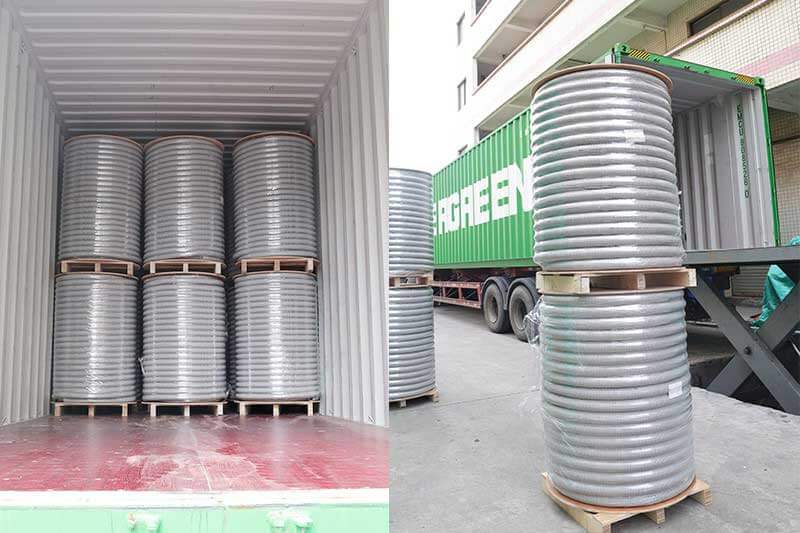
- Flexibilität: ENT ist für eine bequeme Installation konzipiert und bietet hervorragende Flexibilität, um verschiedenen Bauanforderungen gerecht zu werden, insbesondere in Situationen mit Ecken, Hindernissen oder begrenztem Platz. Es spart deutlich Bauzeit und verbessert die Effizienz.
- Leicht: HNO besteht typischerweise aus PVC, das im Vergleich zu Metall leichter ist. Dies erleichtert den Transport und reduziert den Arbeitsaufwand beim Zuschneiden und Verlegen. Es ist die bevorzugte Wahl für Bauherren und Bauunternehmer.
- Feuerbeständigkeit: Wie bereits erwähnt, wird das ENT-Rohr dem vertikalen Flammentest UL1653 unterzogen. Dabei wird sichergestellt, dass es nicht länger als 10 Sekunden brennt und während des Tests keine brennenden oder glühenden Partikel freisetzt. Darüber hinaus dürfen nicht mehr als 25% des verlängerten Teils der Anzeigefahne verbrannt werden. Diese hervorragende Feuerbeständigkeit gewährleistet die Sicherheit bei Konstruktion und Nutzung.
- Betondicht: Ledes bietet optimierte Formulierungen und Verfahren für Beton und unterirdische Umgebungen und ermöglicht mit seinen Schnellkupplungen schnelle und einfache Lösungen. Das gewährleistet effiziente und zuverlässige Installationen.
- Korrosionsbeständigkeit: Die in ENT verwendeten Kunststoffe rosten nicht, sodass selbst bei längerer Vergrabung keine Rostgefahr besteht. Darüber hinaus wird ENT den relevanten UL-Tests unterzogen, die Faktoren wie antimikrobielle Eigenschaften und Wasseraufnahme berücksichtigen. Dadurch eignet es sich sowohl für Wohn- als auch für Gewerbebauprojekte.
- Sicherheit: Das Kunststoffmaterial von ENT bietet eine hervorragende Isolierung und erhöht so die Sicherheit deutlich. Es verhindert elektrische Gefahren und gewährleistet ein hohes Maß an Schutz.
Insgesamt bietet das ENT-Rohr Flexibilität, eine leichte Konstruktion, hervorragende Feuerbeständigkeit, Betondichtigkeit, Korrosionsbeständigkeit und erhöhte Sicherheit aufgrund seiner Isoliereigenschaften.
- Steifigkeit: ENT besteht aus PVC oder Kunststoff und ist daher nicht so starr wie flexible Metallrohre. In bestimmten extremen Einsatzumgebungen kann dies zu Problemen führen.
- Sonnenlichtbeständigkeit: PVC oder Kunststoffe, die in der HNO-Technik verwendet werden, können bei längerer direkter Sonneneinstrahlung altern. In dieser Hinsicht bieten flexible Metallrohre eine bessere Leistung.
- Haltbarkeit: Metallrohre haben unter normalen Umständen, wenn keine Vorfälle wie Rost auftreten, eine längere theoretische Lebensdauer. Allerdings haben aktuelle ENT-Kunststoffrohre auch eine Lebensdauer von über 100 Jahren.
Bei der Auswahl flexibler elektrischer Leitungen ist es wichtig, diese Nachteile zu berücksichtigen, da sie je nach Anwendung und Einsatzumgebung spezifische Auswirkungen haben können.
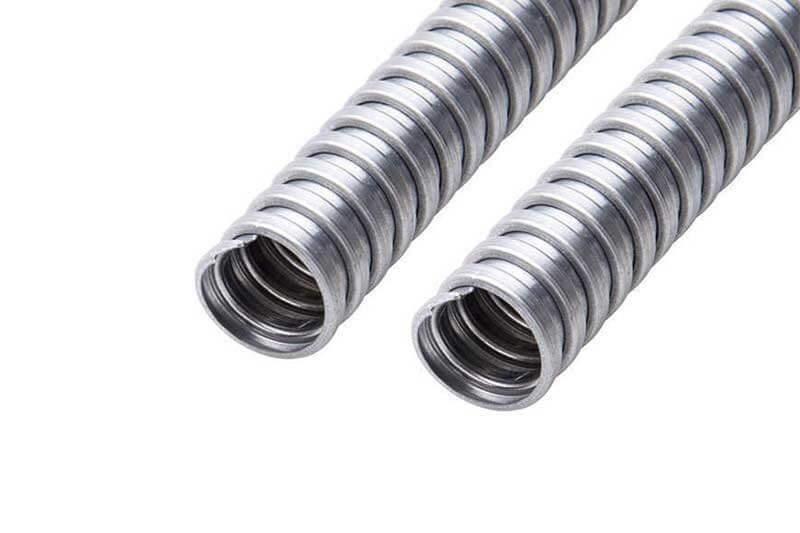
Metal flexible electrical conduit has several commonly used types, here are some introdcution for them.
Flexibles Metallrohr (FMC), auch bekannt als Greenfield oder Flex, ist ein Rohrtyp, der durch Aufwickeln eines gerippten Aluminium- oder Stahlstreifens zu einem Hohlrohr hergestellt wird. Es bietet eine flexible Lösung für die Verlegung und den Schutz elektrischer Leitungen in Bereichen, in denen die Installation starrer, nicht flexibler Rohre wie EMT (Electrical Metallic Tubing) unpraktisch wäre. FMC bietet die Festigkeit eines Metallrohrs und lässt sich gleichzeitig leicht biegen und verformen, ohne dabei seine Form zu verlieren.
- Haltbarkeit: FMC-Rohre bestehen aus Metall, typischerweise Stahl oder Aluminium, und verfügen über wirksame Rostschutzmaßnahmen. Sie sind robust, hart und schlagfest. Dünnwandige Rohrvarianten werden häufig verwendet und gewährleisten nach der Installation eine lange Lebensdauer.
- Flexibilität: Obwohl FMC-Rohre aus Metall bestehen, lassen sie sich dank ihres einzigartigen Herstellungsverfahrens leicht biegen und verformen. Diese Flexibilität erleichtert Aufgaben wie das Einziehen von Kabeln während der Bauphase erheblich und reduziert Installationsschwierigkeiten.
- Rostbeständigkeit: Wie bereits erwähnt, verwenden FMC-Hersteller während der Produktion Rostschutzbeschichtungen. Dies reduziert die Wahrscheinlichkeit von Rostbildung erheblich und gewährleistet die langfristige Nutzung von FMC-Rohren.
- EMI/RFI-Abschirmung: Die Metallstruktur von FMC bietet Abschirmung gegen elektromagnetische Störungen (EMI) und Hochfrequenzstörungen (RFI) und eignet sich daher für Installationen, bei denen elektromagnetische Verträglichkeit eine Rolle spielt. Die Anwendbarkeit dieser Funktion kann jedoch je nach Bauprojekt variieren, daher ist bei der Auswahl eine sorgfältige Abwägung erforderlich.
- Gewicht: Aufgrund ihrer Metallzusammensetzung (meist Stahl oder Aluminium) sind FMC-Rohre im Vergleich zu Kunststoffrohren schwerer. Dieses höhere Gewicht kann bei Installation und Bau zusätzliche Kosten verursachen und zusätzliche Überlegungen erfordern.
- Abnahme der Rostbeständigkeit im Laufe der Zeit: Obwohl FMC-Rohre mit Rostschutzbeschichtungen ausgestattet sind, können diese mit der Zeit ihre Qualität verlieren und die Rostbeständigkeit verringern. Dies kann allmählich zur Rostbildung führen.
Wohn- und Geschäftshäuser: FMC-Rohre eignen sich wie ENT sowohl für den Wohnungs- als auch für den Gewerbebau. Ihr Hauptzweck besteht darin, Kabel und Leitungen in Gebäudestrukturen vor Beschädigungen zu schützen.
Außeninstallationen: Die hervorragende Beständigkeit von FMC-Rohren gegen direkte Sonneneinstrahlung macht sie zu einer guten Wahl für Außenanwendungen. Sie können für Außenbeleuchtung, Beschilderung, Überwachungssysteme, Solarstromanlagen und mehr verwendet werden.
Maschinen und Anlagen: Dank seiner Flexibilität eignet sich das FMC-Rohr ideal zum Schutz von Kabeln in Maschinen und Anlagen. Es hält den rauen Umgebungsbedingungen in industriellen Umgebungen stand und gewährleistet so die Langlebigkeit der Kabel.
Industriebau: Unter Berücksichtigung der Anforderungen im Industriebau und in industriellen Umgebungen erfüllt FMC-Rohre die höheren Anforderungen an Verkabelungs- und Rohrsysteme in Anlagen wie Fabriken. Sie gewährleisten die Sicherheit der internen Verkabelung in diesen anspruchsvollen Anwendungen.
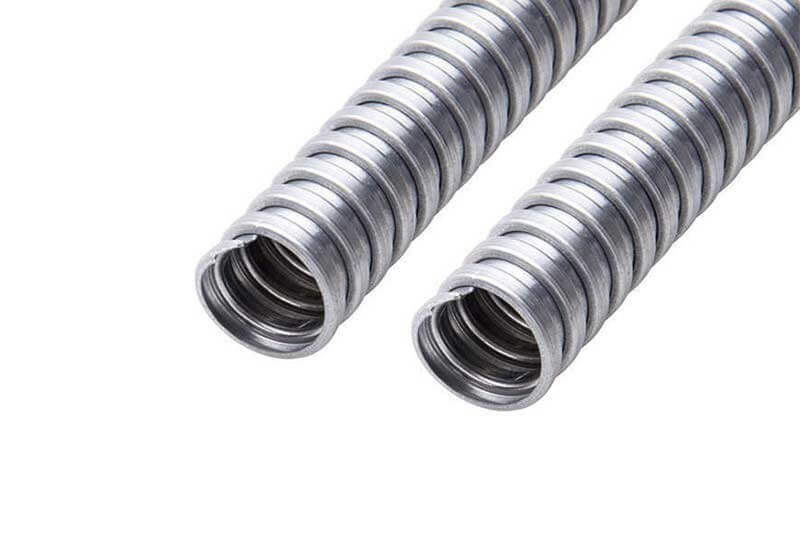
Flexible Metallschläuche (FMT)FMT wird in einem separaten Artikel des US National Electrical Code (NEC) beschrieben und gilt eher als Kabelkanal denn als Leitung. FMT hat einen kreisförmigen Querschnitt, ist flexibel, metallisch und flüssigkeitsdicht ohne nichtmetallische Ummantelung. Es ist in kleineren Handelsgrößen (1/2″ und 3/4″) erhältlich, im Vergleich zur größeren Auswahl an Handelsgrößen für FMC (1/2″ bis 4″).
Daher weist das FMT-Rohr ähnliche Eigenschaften und Merkmale wie das FMC-Rohr auf, und auf weitere Einzelheiten wird hier nicht eingegangen.
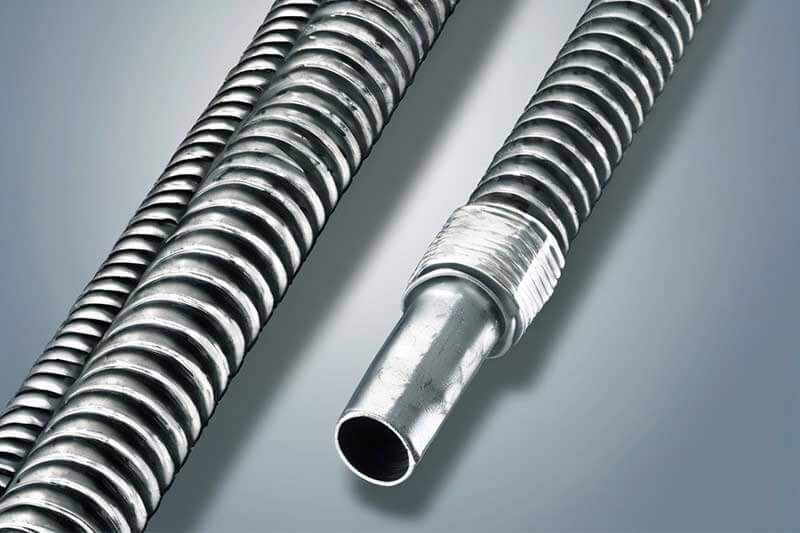
Flüssigkeitsdichtes flexibles Metallrohr (LFMC)Es handelt sich um ein flexibles Metallrohr mit einer wasserdichten Kunststoffschicht, die einen verbesserten Schutz vor Feuchtigkeit bietet. Das Innendesign ähnelt dem von FMC.
- Haltbarkeit: LFMC-Rohre sind äußerst langlebig und eignen sich daher für Anwendungen, die Schutz vor mechanischen Beschädigungen erfordern. Die Kunststoffbeschichtung bietet hervorragende Beständigkeit gegen Rost, Chemikalien und Feuchtigkeit und ist daher ideal für raue Umgebungen.
- Wasserdicht: LFMC-Rohre weisen aufgrund der geringen Wasseraufnahme von PVC oder Kunststoffmaterialien gute wasserdichte Eigenschaften auf. Dadurch eignen sie sich für unterirdische Installationen in feuchten Umgebungen.
- Flexibilität: Wie FMC ist auch LFMC flexibel und lässt sich leicht biegen und manövrieren. Diese Flexibilität ermöglicht die Installation in engen Räumen und Ecken, wo starre Leitungen unpraktisch wären.
- EMI/RFI-Abschirmung: LFMC-Rohre bestehen, ähnlich wie FMC, aus verzinktem Stahl, Aluminium oder Messing als Kernmaterial. Dadurch sind sie gegen elektromagnetische Störungen (EMI) und Hochfrequenzstörungen (RFI) abgeschirmt und eignen sich daher für spezielle Anwendungen.
- Sonnenlichtbeständig: Die Kunststoffbeschichtung von LFMC-Rohren ist normalerweise sonnenlichtbeständig und der Metallkern selbst bietet guten Schutz vor direkter Sonneneinstrahlung.
- Höheres Gewicht: LFMC-Rohre sind aufgrund des Metallkerns und der zusätzlichen Kunststoffbeschichtung schwerer. Dies kann zu höheren Transportkosten führen und zusätzliche Überlegungen bei der Installation erfordern.
- Größerer Außendurchmesser: Der zweischichtige Aufbau des LFMC-Rohrs (Metall + PVC) erhöht die Wandstärke und damit den Außendurchmesser. Dies muss bei der Konstruktionsplanung berücksichtigt werden, um Installationsprobleme zu vermeiden.
- Reduzierte Flexibilität: Die eingeschränkte Biegefähigkeit von LFMC-Rohren ist auf die Kunststoffummantelung und deren enge Verbindung mit dem Metallkern zurückzuführen. Dies ist ein wichtiger Aspekt bei Kauf und Installation.
Wohn- und Geschäftshäuser: LFMC-Rohre können in verschiedenen Umgebungen eingesetzt werden, darunter Einkaufszentren, Wohngebäude und andere Gewerbebauten. Sie eignen sich besonders für feuchtigkeitsgefährdete Bereiche wie Abwasserleitungen, Küchen und feuchte Umgebungen, in denen Kabelschutz unerlässlich ist.
Oberirdische Installation: Die hervorragende Beständigkeit des LFMC-Rohrs gegen direkte Sonneneinstrahlung macht es für oberirdische Installationen geeignet. Es bietet verbesserten Schutz für Kabel, die dem Sonnenlicht ausgesetzt sind, und gewährleistet so deren Langlebigkeit und Leistung.
Maschinen und Anlagen: Der zweischichtige Schutz (Metallkern + Kunststoffummantelung) des LFMC-Rohrs macht es ideal für Maschinen und Anlagen in industriellen Umgebungen. In diesen Umgebungen herrschen oft raue Bedingungen wie Öl- oder Staubbelastung, bei denen das LFMC-Rohr hervorragenden Kabelschutz bietet.
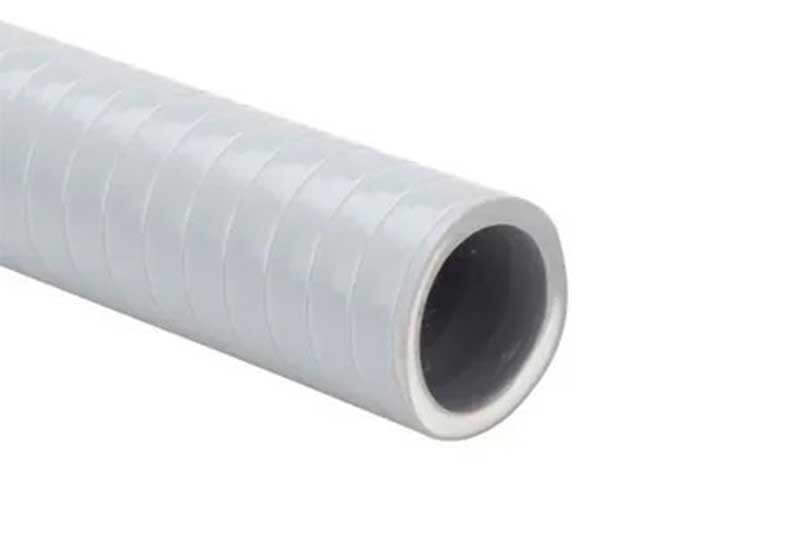
Flüssigkeitsdichtes, flexibles, nichtmetallisches Rohr (LFNC), auch bekannt als FNMC, umfasst verschiedene Arten nichtmetallischer Rohre, die flammhemmend und für elektrische Anwendungen konzipiert sind. Diese Leitungen haben entweder glatte oder gewellte Innenflächen und können eine integrierte Verstärkung in der Rohrwand aufweisen. Sie sind speziell mit einer wasserdichten Ummantelung zum Schutz vor Wasser ausgestattet.
LFNC ist ein flexibles Leitungssystem, das elektrische Kabel und Leitungen umschließt und vor Feuchtigkeit, Flüssigkeiten, Abrieb und äußeren Einflüssen schützt. Im Gegensatz zu herkömmlichen starren Metallleitungen besteht LFNC aus nichtmetallischen Materialien wie PVC (Polyvinylchlorid) oder thermoplastischem Gummi. Diese Zusammensetzung ermöglicht erhöhte Flexibilität bei gleichzeitiger Flüssigkeitsbeständigkeit. LFNC lässt sich leicht biegen, verdrehen und in verschiedene Richtungen verlegen, ohne die Integrität der umschlossenen Kabel zu beeinträchtigen.
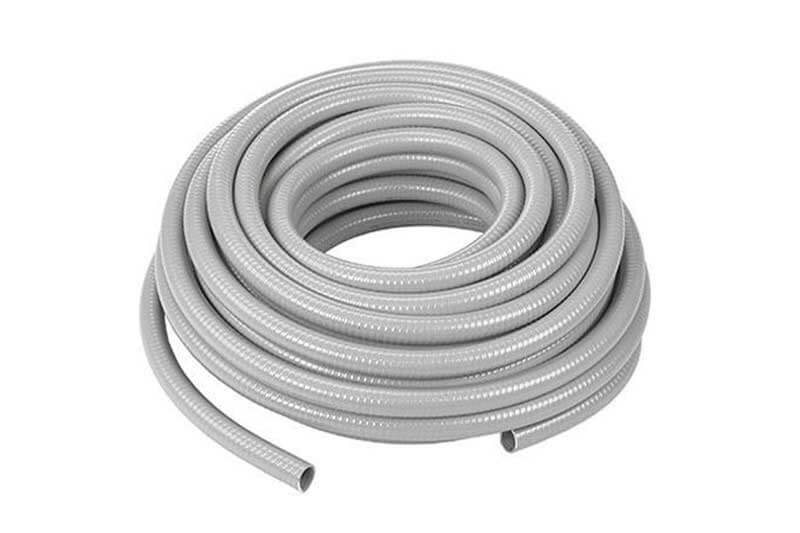
- Flexibilität: LFNC-Rohre sind flexible Schläuche und lassen sich leicht biegen und manövrieren. Im Gegensatz zu LFMC-Rohren enthalten sie kaum oder gar keine Metallkomponenten, wodurch sie sich relativ leicht biegen lassen, ohne ihre Integrität zu beeinträchtigen.
- Leicht: Obwohl einige Varianten verstärkt sind, sind LFNC-Rohre im Vergleich zu Stahlrohren wie FMC leichter. Dies kann zu Kosteneinsparungen bei Transport und Installation führen.
- Kosteneffizient: Aufgrund der geringeren Rohstoffkosten sind LFNC-Rohre im Allgemeinen günstiger als FMC- oder LFMC-Rohre. Dies kann dazu beitragen, Projektbudgets zu reduzieren, ohne den Kabelschutz zu beeinträchtigen. Dieser Faktor sollte jedoch im Zusammenhang mit den spezifischen Projektanforderungen berücksichtigt werden.
- Wasserdicht: LFNC-Rohre weisen aufgrund der geringen Wasseraufnahme von Kunststoffen gute wasserdichte Eigenschaften auf. Dadurch eignen sie sich für unterirdische Installationen in feuchten Umgebungen.
- Korrosionsbeständigkeit: Da LFNC-Rohre nichtmetallisch sind, besteht kein Korrosionsrisiko, das üblicherweise bei Metallrohren auftritt. Dies ist insbesondere bei Installationen von Vorteil, bei denen das Rohr korrosiven Substanzen ausgesetzt sein kann.
- UV- und Sonnenlichtbeständigkeit: Einige LFNC-Produkte sind mit UV- und Sonnenlichtbeständigkeitseigenschaften formuliert und bieten Schutz vor längerer Einwirkung von UV-Strahlen und direkter Sonneneinstrahlung.
- Haltbarkeit: Da LFNC-Rohre nichtmetallisch sind, weisen sie im Vergleich zu FMC- oder LFMC-Rohren möglicherweise eine geringere physikalische Festigkeit und Schlagfestigkeit auf. Theoretisch sind sie möglicherweise weniger langlebig.
- Gewicht: LFNC-Rohre sind zwar leichter als Metallrohre, aber schwerer als ENT-Rohre (Electrical Nonmetallic Tubing). Auch ihre Flexibilität erreicht nicht die von ENT-Rohren.
Wohn- und Geschäftshäuser: LNFC-Rohre können in verschiedenen Umgebungen eingesetzt werden, darunter Einkaufszentren, Wohngebäude und andere Gewerbebauten. Sie eignen sich besonders für feuchtigkeitsgefährdete Bereiche wie Abwasserleitungen, Küchen und feuchte Umgebungen, in denen Kabelschutz unerlässlich ist.
Außeninstallation. LFNC-Rohre weisen eine hervorragende Beständigkeit gegen direkte Sonneneinstrahlung und eine erhöhte Festigkeit auf, sodass sie in Szenarien mit höheren Anforderungen verwendet werden können, wie z. B. in Straßenbeleuchtungssystemen im Freien, Sicherheitssystemen und Szenarien zum Schutz von Kabeln hydraulischer Bewässerungssysteme.
Industrie- oder Chemiestandort. Da LFNC beständig gegen chemische Korrosion ist, kann es zum Kabelschutz unter rauen Arbeitsbedingungen verwendet werden, beispielsweise als Kabelschutz für große mechanische Geräte, Chemieanlagen usw.
Die Installation flexibler Metallrohre (FMC) umfasst mehrere Schritte, um eine sichere und ordnungsgemäße Installation zu gewährleisten. Hier ist eine allgemeine Anleitung zur Installation von FMC:
- Besorgen Sie sich die notwendigen Werkzeuge und Materialien: Sie benötigen FMC, Steckverbinder, einen Rohrschneider, ein Universalmesser, einen Schraubendreher und geeignete Befestigungselemente.
- Planen Sie die Leitungsroute: Bestimmen Sie den Installationspfad des FMC und berücksichtigen Sie dabei alle Hindernisse, Biegungen und Ecken. Stellen Sie sicher, dass die örtlichen Elektrovorschriften eingehalten werden.
- Messen und schneiden Sie das FMC: Messen Sie die benötigte FMC-Länge für jeden Abschnitt der Leitungsführung. Schneiden Sie die FMC mit einem Rohrschneider auf die passende Länge zu. Stellen Sie sicher, dass die Schnittenden glatt und gratfrei sind.
- Installieren Sie die Anschlüsse: Befestigen Sie an beiden Enden des FMC entsprechende Anschlüsse. Je nach verwendetem FMC-System können die Anschlüsse Kompressions- oder Stellschraubenanschlüsse sein. Befolgen Sie die Anweisungen des Herstellers für die ordnungsgemäße Installation.
- Sichern Sie die Anschlüsse: Befestigen Sie die Steckverbinder mit einem Schraubendreher oder einem anderen geeigneten Werkzeug fest am FMC. Achten Sie auf eine sichere Verbindung, die ein Lösen des Kabelkanals verhindert.
- Montieren Sie das FMC: Befestigen Sie das FMC mit geeigneten Befestigungsmitteln wie Bändern oder Klemmen sicher an der gewünschten Oberfläche. Stellen Sie sicher, dass das Rohr in regelmäßigen Abständen ausreichend gestützt wird, um ein Durchhängen zu verhindern.
- Kurven und Wendungen machen: Verwenden Sie bei Bedarf einen Rohrbieger oder Rohrschraubstock, um Biegungen und Kurven im FMC zu erzeugen. Beachten Sie die Biegeanweisungen des Herstellers und vermeiden Sie die Überschreitung der Biegeradien.
- Anschluss an elektrische Geräte: Befestigen Sie das FMC mit geeigneten Anschlüssen an Schaltkästen, Anschlussdosen oder anderen elektrischen Geräten. Stellen Sie die ordnungsgemäße Erdung gemäß den elektrischen Vorschriften sicher.
- Sichern Sie die Kabel im FMC: Verlegen Sie die elektrischen Kabel oder Leitungen im FMC und befestigen Sie sie mit geeigneten Kabelbindern oder Klemmen. Dies verhindert Bewegungen und schützt die Kabel im Kabelkanal.
- Überprüfen Sie die Installation: Überprüfen Sie die FMC-Installation, um sicherzustellen, dass sie allen geltenden elektrischen Vorschriften und Bestimmungen entspricht. Achten Sie auf ordnungsgemäße Unterstützung, sichere Anschlüsse und korrekte Verlegung.
Beachten Sie unbedingt die örtlichen Elektrovorschriften und -bestimmungen und befolgen Sie die Anweisungen des Herstellers für das zu installierende FMC-System. Bei Unsicherheiten während der Installation wenden Sie sich bitte an einen zugelassenen Elektriker.
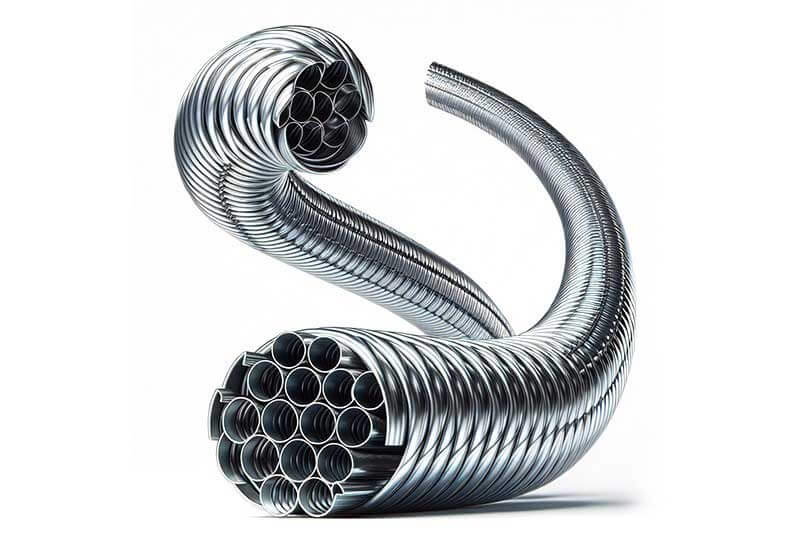
Bei der Auswahl des geeigneten Wellrohrprodukts sollten Sie die folgenden fünf allgemeinen Faktoren berücksichtigen:
- Erfordernis: Bewerten Sie die grundlegenden Anforderungen Ihres Projekts oder Ihrer Anwendung anhand der Umgebung. Wird das Rohr in einem typischen Wohngebäude verlegt oder über einen längeren Zeitraum den Außenbedingungen ausgesetzt? Wird es an einem dauerhaft feuchten Ort eingesetzt? Durch die Abwägung der Vor- und Nachteile der verschiedenen Wellrohrprodukte können Sie eine fundierte Entscheidung treffen. Als Projektauftragnehmer oder Händler kontaktieren Sie uns gerne für weitere Kaufberatung.
- Budget: Wählen Sie ein Produkt, das zu Ihrem Projekt passt und in Ihr Budget passt. So stellen Sie sicher, dass Sie die Projektanforderungen erfüllen und gleichzeitig die Beschaffungskosten minimieren. Darüber hinaus ist es wichtig, bei der Budgetplanung auch die Transport- und Installationskosten zu berücksichtigen. Wie bereits erwähnt, sind Metallrohre beispielsweise schwerer, was zu höheren Transport- und Installationskosten führt. Daher sollten diese Kosten in das Gesamtbudget einkalkuliert werden.
- Lokaler Code: Nachdem Sie Material und Art des Rohrs bestimmt haben, müssen Sie unbedingt die lokalen Anforderungen und Vorschriften für solche Rohre kennen. Der Kauf von Wellrohrprodukten, die den lokalen Normen entsprechen, ist entscheidend. Nicht konforme Produkte bestehen die Prüfung nicht. Wenn Sie beispielsweise ENT-Rohre in Nordamerika verwenden, müssen Sie Produkte kaufen, die den Normen UL1653 und CSA C22.2 Nr. 227.1 entsprechen, um die lokalen Installationsanforderungen zu erfüllen und zusätzliche Kosten zu vermeiden.
- Größe & Menge: Bestimmen Sie die Anzahl der Drähte oder Kabel, die in einem einzelnen Kabelkanal untergebracht werden müssen, sowie die geschätzte Länge und Menge, die für Ihre Installationsanforderungen erforderlich ist. So bleiben Sie innerhalb Ihres Budgets und sparen Kosten.
- Marke: Verschiedene Arten von Leitungen sind mit verschiedenen Marken verbunden. Der Kauf von Produkten renommierter Marken kann etwas teurer sein, aber der Qualitätsunterschied ist erheblich. Bekannte Marken lassen ihre Produkte nach lokalen Standards zertifizieren. Die Wahl unbekannter oder generischer Produkte kann zu Qualitätsproblemen führen, die zu Verlusten führen, die den Wert der Produkte selbst bei weitem übersteigen. Wenn Ihnen die Preise lokaler Marken zu hoch erscheinen oder Sie große Mengen benötigen, können Sie auch den direkten Kauf bei Herstellern wie Ledes in Betracht ziehen. Als Hersteller bietet Ledes wettbewerbsfähige Preise, da es keine Markenvermittler gibt. Mit über 14 Jahren Erfahrung im Export und Tausenden von Kunden können wir eine pünktliche Lieferung Ihrer Bestellung sicherstellen, sobald Spezifikationen und Anforderungen bestätigt sind. Wenn Sie uns bei produktbezogenen Fragen konsultieren möchten, Klicken Sie hier, um uns eine E-Mail zu senden.
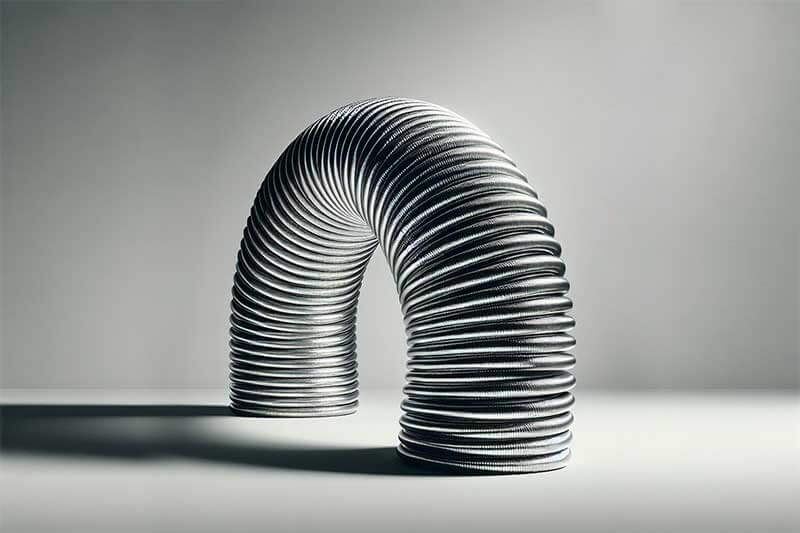
Ja, bestimmte Arten von flexiblen Leitungen können vergraben werden. In Nordamerika gibt der NEC (National Electrical Code) Richtlinien für die zulässige Verwendung verschiedener Leitungstypen vor.
Für ENT-Leitungen (Electrical Nonmetallic Tubing, nicht metallische elektrische Leitungen) heißt es in der 6. Bestimmung gemäß NEC-Artikel 362.10 „Zulässige Verwendungen“:
„Eingefasst in gegossenen Beton oder eingebettet in eine Betonplatte auf ebenem Boden, wobei ENT auf Sand oder zugelassenen Abschirmungen platziert wird, vorausgesetzt, es werden für diesen Zweck vorgesehene Armaturen für die Verbindungen verwendet.“
Für LFNC-Rohre (Liquidtight Flexible Nonmetallic Conduit) gilt gemäß NEC-Artikel 356.10 „Zulässige Verwendungen“ in der vierten Bestimmung:
„Zur direkten Bestattung, sofern aufgeführt und als solcher gekennzeichnet.“
Um zu ermitteln, ob das von Ihnen erworbene flexible Rohr vergraben werden kann, müssen Sie die entsprechenden örtlichen Genehmigungsunterlagen zu Rate ziehen und die örtlichen Vorschriften einhalten.
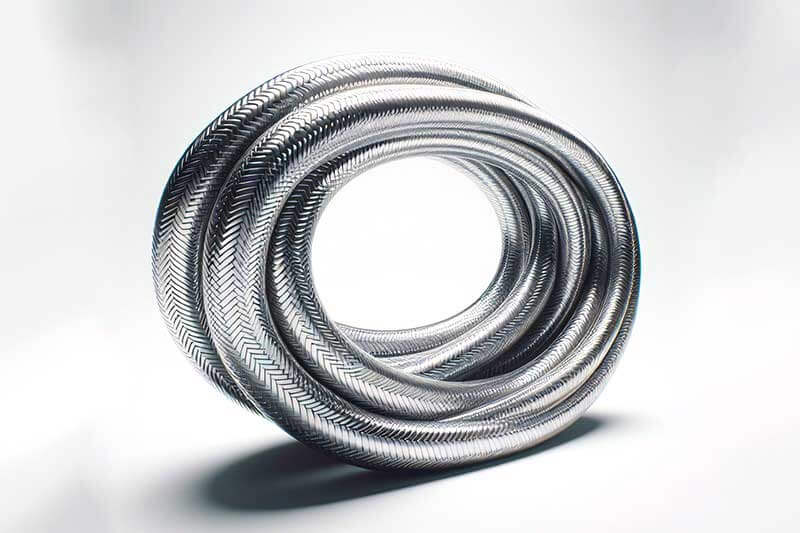
Es gibt keine eindeutige Antwort darauf, ob Kunststoff- oder Metallrohre besser sind. Es hängt davon ab, welches für Ihre spezifischen Anforderungen besser geeignet ist, da jedes Rohr seine eigenen Vor- und Nachteile hat.
Vor- und Nachteile von Metallrohren:
Metallrohre sind für Hausbesitzer bei ihren elektrischen Systemen oft die bevorzugte und traditionellere Wahl. Sie haben eine lange Lebensdauer und sind im Allgemeinen die haltbarste Option. Metallrohre werden normalerweise aus Kupfer, Messing, Gusseisen oder Stahl hergestellt. Der Hauptvorteil von Metallrohren ist ihre höhere Härte und längere theoretische Lebensdauer. Allerdings sind Metallrohre schwerer, was zu höheren Transport- und Installationskosten führt, und sie können rosten, was zu höheren Wartungskosten führt. Hersteller haben Lösungen entwickelt, um das Rostproblem zu lösen, wie z. B. Oberflächenbeschichtungen oder die Verwendung von flüssigkeitsdichten flexiblen Metallrohren (LFMC) mit einer Kunststoffbeschichtung, normalerweise aus PVC. Diese Lösungen erhöhen jedoch das Gewicht und den Durchmesser des Metallrohrs.
Vor- und Nachteile von Kunststoffrohren:
Der Hauptvorteil von Kunststoffrohren ist ihr geringes Gewicht und ihre Rostbeständigkeit, wodurch die Nachteile von Metallrohren überwunden werden. Das geringere Gewicht bedeutet Kosteneinsparungen bei Transport und Installation und sie lassen sich leichter schneiden, anschließen und biegen. Mit dem technologischen Fortschritt wurden auch die Hitzebeständigkeit, Korrosionsbeständigkeit und andere Eigenschaften von Kunststoffrohren verbessert, sodass sie für die meisten Anforderungen im Wohn- und Gewerbebau geeignet sind. Der Hauptnachteil von Kunststoffrohren besteht darin, dass sie nicht so hart wie Metallrohre sind und daher in bestimmten Extremsituationen anfällig für Beschädigungen sein können. Darüber hinaus sind Kunststoffrohre möglicherweise nicht so hitze- und UV-beständig wie Metallrohre, was möglicherweise zu schnellerer Alterung und Bruchgefahr führt, wenn sie über einen längeren Zeitraum in solchen Umgebungen verwendet werden.
Aus dem obigen Vergleich geht hervor, dass Kunststoff- und Metallrohre ihre eigenen Vor- und Nachteile haben und sich ergänzen. Die Wahl des geeigneten Materials basierend auf Ihren spezifischen Anforderungen oder Projektanforderungen ist eine kluge Entscheidung.
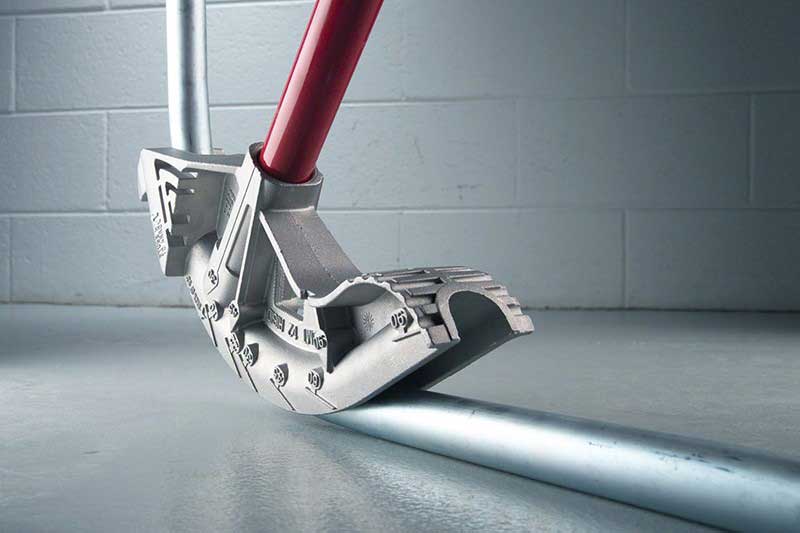
- Rohrbiegen: Unabhängig davon, ob es sich um ein Metall- oder Kunststoffrohr handelt, können Sie Werkzeuge verwenden, um das Rohr in den gewünschten Winkel zu biegen. Der genaue Vorgang kann je nach Rohrmaterial variieren, aber im Allgemeinen wird ein Rohrbieger oder ein Biegewerkzeug verwendet, um den gewünschten Biegewinkel zu erreichen.
- Verwenden Sie Leitungsverbindungen: Rohrverschraubungen wie Bögen oder Winkelstücke sind so konzipiert, dass sie sanfte Eckübergänge ermöglichen, ohne das Rohr zu beschädigen. In Nordamerika sind beispielsweise standardmäßige Rohrwinkelverschraubungen in verschiedenen Winkeln wie 22,5°, 45°, 90° usw. erhältlich. Sie können die passende Verschraubung basierend auf Ihrer Rohrgröße auswählen und sie anschließen, um den gewünschten Eckwinkel zu erreichen.
Beachten Sie bitte, dass Sie bei der Verwendung von PVC-Rohren speziellen PVC-Kleber oder -Klebstoff verwenden müssen, um eine sichere Verbindung zu gewährleisten, die sich nicht löst.
- Verwenden Sie ein flexibles PVC-Rohr: Wenn der Eckwinkel nicht zu spitz ist, kann die Verwendung eines flexiblen PVC-Rohrs eine praktische Option sein. PVC-Flexrohre bestehen aus Kunststoff und können leicht von Hand gebogen werden, ohne dass spezielle Biegewerkzeuge erforderlich sind. Dies erleichtert den Installationsvorgang, insbesondere bei kleineren Winkelbiegungen.
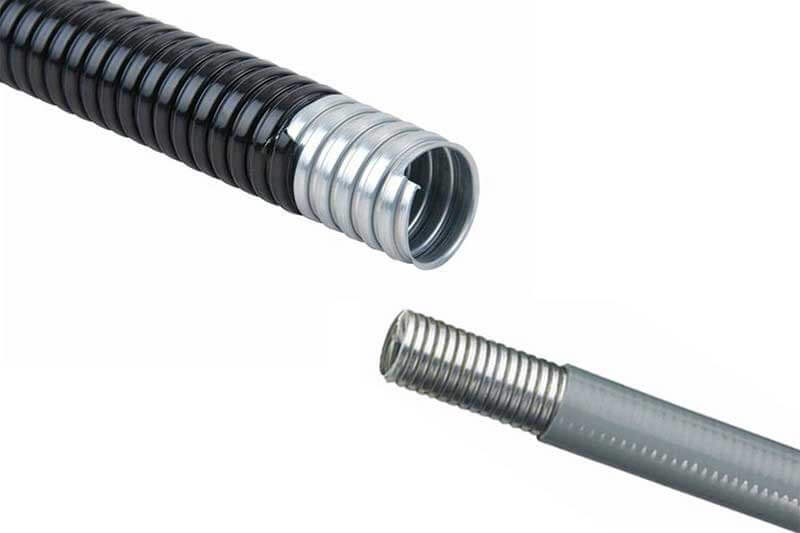
Gemäß den NEC-Richtlinien (National Electrical Code) können flexible Leitungen in verschiedenen Situationen eingesetzt werden. Hier sind die allgemeinen Anwendungen:
ENT (Electrical Nonmetallic Tubing) und LFNC (Liquidtight Flexible Nonmetallic Conduit): Diese Rohre eignen sich zum Eingießen in Beton, zum Vergraben im Untergrund oder für den Einsatz in Decken und abgehängten Installationen. Sie können auch im Boden verwendet werden, beispielsweise für Solarstromanlagen oder Außeninstallationen, da Kunststoffrohre eine gute UV- und Sonnenlichtbeständigkeit aufweisen.
FMC (Flexible Metal Conduit): FMC ist für den Einsatz in trockenen Umgebungen geeignet, da es weniger rostbeständig ist. Es kann für verschiedene Anwendungen verwendet werden, bei denen Flexibilität erforderlich ist, z. B. in mechanischen Geräten, Hochtemperaturumgebungen und Bodeninstallationen wie Solarenergiesystemen oder Außeninstallationen. In Umgebungen mit starkem Staub- oder Öl-/Gasvorkommen ist es jedoch wichtig, die flüssigkeitsdichte Leitungsserie zu verwenden, um die Sicherheit zu gewährleisten.
LFMC (Liquidtight Flexible Metal Conduit) und LFNC (Liquidtight Flexible Nonmetallic Conduit): Diese Rohre sind für den Einsatz in feuchten Umgebungen konzipiert, da sie eine gute Wasserbeständigkeit bieten. Sie können in Umgebungen mit Feuchtigkeit verwendet werden und bieten Schutz vor eindringendem Wasser. LFMC- und LFNC-Rohre eignen sich für Anwendungen, die Flexibilität erfordern.
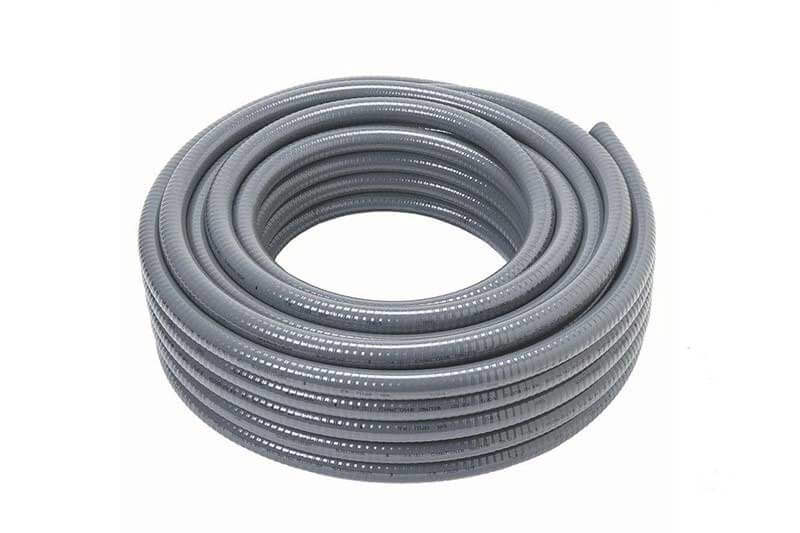
Nicht alle flexiblen Leitungen sind wasserdicht. Im Allgemeinen sind FMC (Flexible Metal Conduit) und ENT (Electrical Nonmetallic Tubing) nicht wasserdicht. Für wasserdichte Anwendungen sollten Leitungen mit der Bezeichnung „flüssigkeitsdicht“ verwendet werden, wie z. B. LFMC (Liquidtight Flexible Metal Conduit) und LFNC (Liquidtight Flexible Nonmetallic Conduit).
Es ist wichtig zu verstehen, dass FMC- und ENT-Rohre, einschließlich ihrer Verbindungen, keine integrierten Abdichtungsfunktionen haben. ENT besteht aus Kunststoff und hat daher eine geringe Wasseraufnahme, sodass es ohne größere Probleme kleine Wassermengen verträgt. FMC hingegen besteht aus Metall und hat eine dünne Beschichtung, die keine wesentliche Abdichtung bietet.
Die Schutzschläuche der Liquid-Tight-Serie hingegen verfügen über verstärkte Kunststoffaußenschichten und wasserdichte Verbindungen und sind somit für den Einsatz in feuchten Umgebungen geeignet. So ist die Sicherheit Ihrer Kabel gewährleistet.
Flexible Elektrorohre bieten eine vielseitige Lösung für verschiedene Elektroinstallationen und spielen in einer Vielzahl von Anwendungen eine wichtige Rolle. Ihre Bedeutung liegt in ihrer Fähigkeit, elektrischen Verdrahtungssystemen Flexibilität, Schutz und Vielseitigkeit zu verleihen.
Diese Leitungen werden häufig im Wohn-, Geschäfts- und Industriebereich verwendet.
Sie sind unverzichtbar für Anwendungen wie Betonummantelung, Erdverlegung, Decken- und Hängeinstallationen sowie Außeninstallationen wie Solarstromanlagen. Die Flexibilität dieser Leitungen ermöglicht eine einfache Installation um Hindernisse herum und macht sie ideal für komplexe Verkabelungskonfigurationen.
Wenn Sie weitere Fragen haben oder Hilfe mit flexiblen elektrischen Leitungen benötigen, wenden Sie sich bitte an Kontaktieren Sie uns per E-Mail oder Gipfel ein Formular. Wir helfen Ihnen, Ihren Bedarf an Elektroleitungen zu decken.



